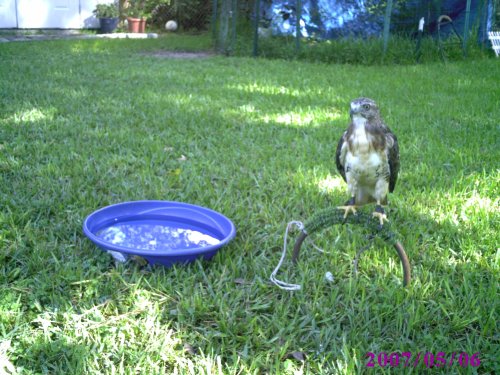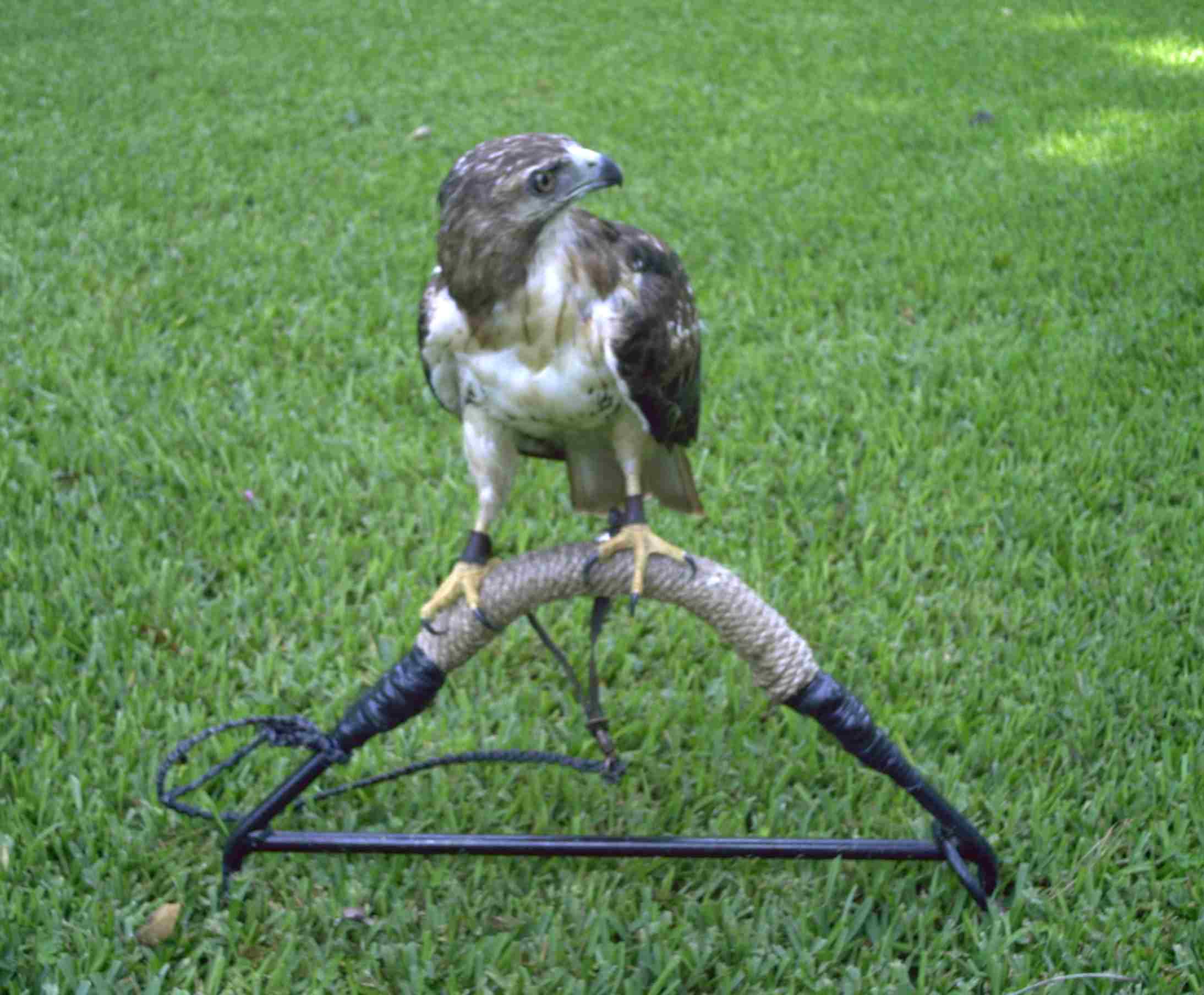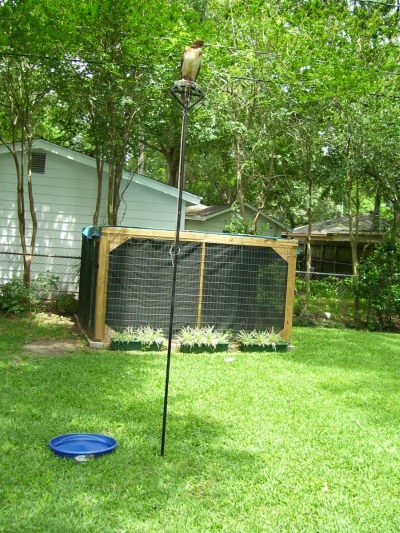New Ringless Perching Systems, Including a "U Perch"
I
read an article from the August 1996 Hawk Chalk, called
"Training Schemes For Achievable Dreams, " written by
Steve Martin. Generally a really good article, but what caught my eye
was a comment that one should tie a bird to a bow perch without using
the ring. Martin's reasoning is that the sliding ring sometimes keeps
the bird from having access to the bath pan. I have seen this. Birds
usually hop to the pan, rather than bate to it, thus if the ring is
on the other side of the bow, they can't easily get to the pan. His
answer is to cut off the ring and tie the bird to one of the posts,
putting the bath pan on the same side as the bird is tied. I tried it
on my bow perch - the system works well. My molting RT bathed for the
first time within a day of switching. Another advantage is that using
his system increases the effective size of your enclosed weathering
area by a couple of feet in each direction. Why? Because the sliding
ring usually travels two to three feet, which moves your bird closer
to the perimeter of your yard. Mr. Martin's comments about perching
are quietly revolutionary. The only reason that traditional bow
perches are so wide is to accommodate the sliding ring. That makes
them expensive, bulky, and forces the austringer to have a bigger
weathering area.
As
an engineer, I felt compelled to design a perch for this system. A
yard perch needs four attributes to be successful: A good perching
surface, safe in terms of avoiding leash fouling, adequate tail
clearance, and a short enough leash such that the bird cannot get
sufficient speed to cause a damaging bate. I designed a perch then
found that a 10" U-bolt was just fine, very close to my design.

9/18/2006 - New U perch with leash tied at the end where the bath pan is located. Less than 13" wide, about 7" or 8" high perching surface, which provides ample tail clearance. Structure cost $16.
|
| 
7/23/2006 - A small welded
bow perch tied without the sliding ring, which is sitting unused at right end. This idea was suggested by Steve Martin is his article. The perch is
about 22" wide, narrow compared with some bow perches which are over 30" wide. $83
|
Supplies
for U-Bolt Perch (U perch):
10"
Pipe U-Bolt which is about 14” tall (McMaster-Carr Supply: as of 10/3/2006 the part number is 8880 T18 - $16 plus shipping)
3"
X 9" piece of Astroturf
Twine, roughly 1/8" diameter
UV
resistant tie wraps
Electrical
Tape
Click this link: U-Bolt
McMaster (www.mcmaster.com) charges $16 plus shipping
for a U-bolt of mild steel; $120 for stainless steel. To finish the
perch, build up the perch surface diameter a little with a few wraps
of twine and then cover in electrical tape. Don't
overdo it. This should take less than five or ten minutes. The
twine does not have to be wrapped very densely, but should be
tight. Just a few wraps criss-crossed, and should cover just less
than 8 inch of the top of the bow, centered. Before you place the Astroturf, cut some notches along the edge, which will help it lie on the curve. Place the Astroturf strip and secure it with about six or eight UV
resistant tie wraps. Secure the ends. Run some stiff wire wire
horizontally across the bottom of the perch, about 6" from the
threaded ends, or weld a bar across. If, for some reason, the hawk pulls the perch out of
the ground, the leash will not slip off. This perch is heavy, about 5
pounds so it is unlikely to get pulled up, but take the precaution
anyway.
If the ground is too hard to push the perch in, hammer a stake
about 7" or 8" into the ground, pull out and do the other side,
using the perch to measure the distance. Just lay the perch down where you want your holes. A 3/4" X 8" long hex head cap screw works as a stake and is available at Lowes or Home Depot for about $3. Hammer it in, pull it out and do the other side. Use eye and hearing protection whenever hammering anything. You want the perch to be pushed in about 7 or 8 inches, as adequate
tail clearance is the key. If it is tight, just hammer the screw again into the hole, and take it out. As long as the tail clears, I believe the deeper the better, which means less perch exposed. Put one post at the center of your
weathering yard and tie to it. Put the bath pan on that side. When
the bird fouls the surface of the yard, pivot the perch around the
center hole for a fresh surface.
This U
perch design is compact, simple and safe. If your bird tries to crawl
under the bow, put a cable or strap across the semicircle. A bungee
leash may be recommended to absorb the shock of a bate, though I have my doubts as to their effectiveness. The U perch will cost much less than a ring perch or
traditional bow perch.
If
you don't want to drive a stake into the ground, a similar perch may
be made from ½ inch or 5/8 inch material with ground ends.
Click this link to see the drawing. Probably will cost between $40
and $60 from a welder. Click this link for drawing: Welded Perch
I realized
something else. If you want a completely tangle free tethering
system, don't tie to the perch at all. This is what I do in my mew,
and can be done in the weathering yard. Stake the bird away from the perch at the
center point of the yard, using a 12" eye bolt pushed into the
ground. Place the perch (or even perches) anywhere within the radius
of the leash, with the legs of the perch both in line with the leash,
rather than perpendicular. Tie the leash to the eye. The swivel end
of the leash is somewhere in the middle of the perch. I place a two
or three foot tall potted plant just outboard of the perch to prevent
the bird from bating outward and possibly smashing his tail. The
plant should prevent this. The picture on web site shows two perches,
a center eye bolt and bath pan. The bird seems to enjoy having more
than one perch and will hop back and forth. He bates less than with
one perch. Although this eye-bolt system is virtually tangle
free, it does have some possible risks. Though unlikely, the bird
might fly right into the plant and mash his tail on the perch. Also
you will want to minimize the length of the leash so that if he flies
the full leash distance he is not going too fast. I tie the leash
just long enough so the he can sit comfortably on the perch, but
cannot walk around it and get tangled. Here is how it looks:

Hawk with various perches
I enlarged my
yard to accommodate a 22"wide bow perch, which was unnecessary.
Alternatives include multiple perches and the eye-bolt, Steve
Martin's method of tying to a regular bow perch, or make the U
perch, again tying to one post at the center of the yard. You will
keep your bird at least a foot closer to the center of your yard and
away from the fence. When the bird fouls one area, just pivot around
that point and you have new turf. Of course in a small weathering
area, a ring perch works fine, but this little U perch is
simpler, smaller, and probably less likely to tangle.
I recently added rubber mulch to the ground in the weathering area. It needs to be about 2 -3 inches thick and placed where ever the bird will land - I put a semicircle around the post where the bird is tethered. It is soft on the feet, and will keep the talons sharp, but I put a piece of marine carpet down if I feed him on the ground, as it will stick to the food.
Here is a spread sheet for evaluating perches. The score is based on the desired characteristic times its weighting factor. Likelihood of feather damage, tangling, access to bath pan, leash length (bate), cost, and space in the yard are the categories. The weighting factors are vital (e.g. tangling), important (e.g. access to bath pan), and desired (e.g. cost). Values are 3,2,1 respectively. The "Super Ring" perch is a rotating ring perch, virtually impossible to tangle the leash. This may be the best perch, though is expensive. The one shown here sells for $260. I believe that the U perch is nearly as good, allowing a slightly shorter leash. The U perch is more than an order of magnitude less expensive. See the picture below. Incidentally, the tiercel goshawk pictured is also called "Cisco." Perch Spreadsheet

Cisco, the goshawk, on $260 rotating ring perch
|

5/6/2007 - My red-tail on another perch. A tall perch is something advocated by Dave Mancini. He leaves birds out in all weather, unattended, with no problems. I am not that brave, but it works well as an ATTENDED yard perch. The bird sits quite relaxed for hours, rarely bating. Dave's link below. http://www.falconrybirds.com/Pages/carefacilities.shtml
|
Email with Questions or Comments: cisco@virtualvideo.cc



